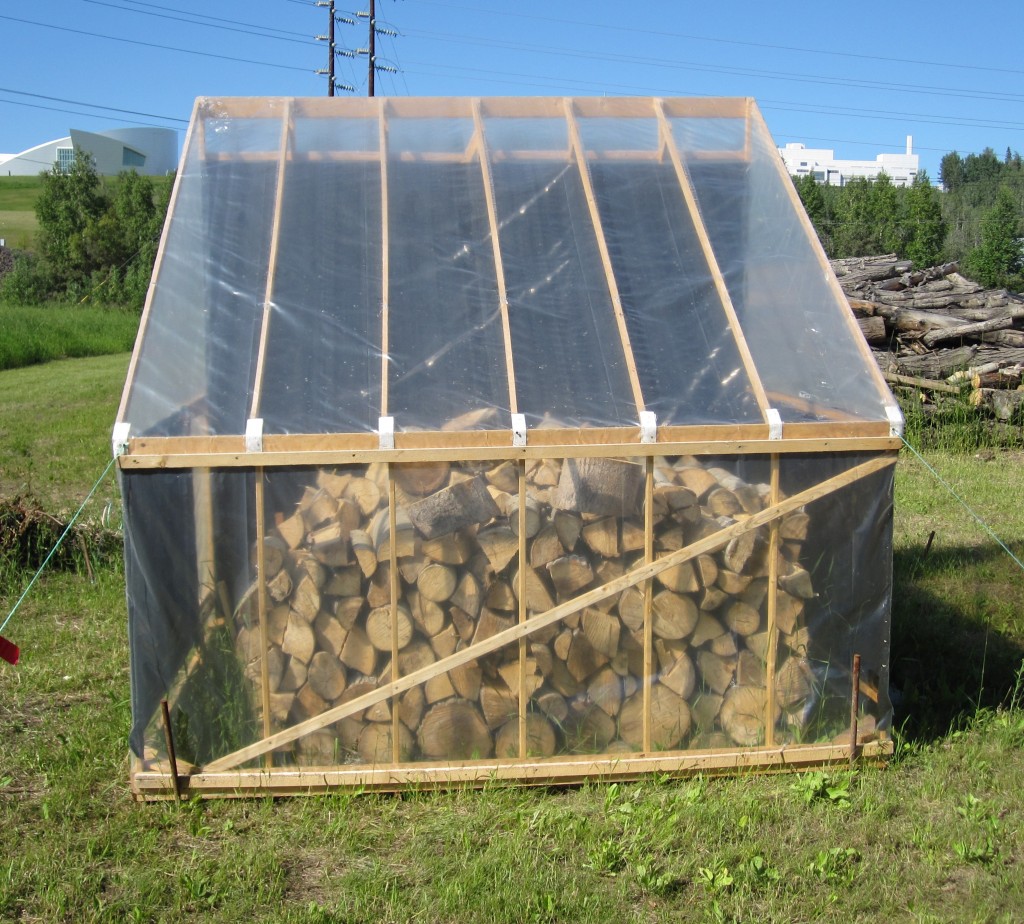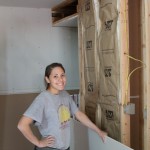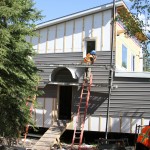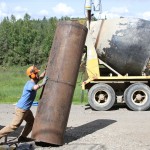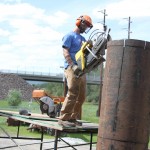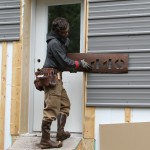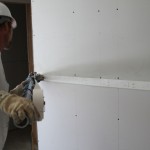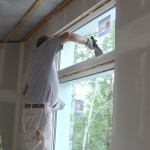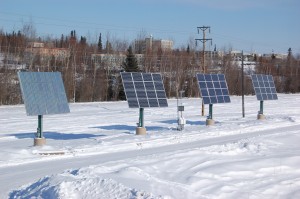It’s finishing time at the Sustainable Village! The devil is in the details, and we’re detailing ceilings, floors, corners, railings, trim, and everything else. The time lapse shows workers installing beautiful birch paneling on the upstairs ceiling as well as cabinets and appliances.
Tag Archives: cold climate housing research center
What to look for in an energy efficient house
Shopping for a home in Fairbanks can be difficult, especially if energy efficiency is a priority. With heating oil prices volatile and resale value at stake, finding the most fuel-efficient home makes sense.
Following are just a few of the things to look for in an efficient home.
Site Location
- South-facing slopes that are exposed to sunlight will be warmer in the winter and require less heating than comparable homes on north-facing slopes or obscured by dense tree canopies. Deciduous trees, such as Alaska birch, are desirable because they lose their leaves in winter and allow sunlight to shine through.
- Ideally, homes should be situated lengthwise east to west in order to take advantage of the sun.
- Protection from wind, provided by trees or hills, can help to conserve heat in winter. Low-lying evergreens or shrubs placed on the sides of a house that are exposed to wind will also help conserve heat.
Design
- Houses that share common walls with other structures, such as townhomes, lose less heat than standalone homes.
- The overall shape of the house will affect heat loss due to the amount of wall space exposed to the elements. L-shaped, H-shaped, or U-shaped homes, for example, will tend to lose more heat than rectangular homes.
- Arctic entryways that are sealed from the outside and the inside living areas by separate doors can help retain heat.
- South-facing windows are preferable to windows on any other axis because they can collect sunlight and minimize heat loss.
- Plumbing should be run inside heated or indirectly heated areas and consolidated as much as is practical. Sinks, baths, and laundry should be close to the water heater to minimize standby heat loss or, alternatively, on-demand water heaters can be used.
Insulation
- There’s a saying among energy raters in Alaska – “You can’t over-insulate, you can only under-ventilate.” When inspecting a house, ask how much and what type of insulation is in the floor, walls, and attic. Other than airtight construction, no other single factor will affect a home’s energy use more than insulation. But insulation without adequate ventilation will invite moisture problems.
- All gaps and cracks in the house should be well sealed or caulked.
- Doors and windows need effective weather-stripping.
Mechanical Systems
- The performance of heating appliances such as boilers can vary widely and replacing an aging existing system can be expensive. It’s not uncommon for heating systems to be oversized in relation to a homes energy needs, which can also contribute to efficiency losses. Consider having the heating system professionally inspected to assess reliability and performance.
- Doors and windows need effective weather-stripping.
- Previous years’ fuel bills can help gauge heating costs, but be aware that the presence of a woodstove, pellet stove, or other heating appliance other than the boiler can make heating oil usage numbers misleading.
Home Inspections
- Check to see if the home has already had an energy audit done. An energy audit will provide a detailed assessment of the home’s energy performance and will help identify problem areas. If energy efficiency is a priority, an audit/home inspection by a state certified energy rater can provide valuable insight into a home’s real world performance.
UAF Sustainable Village Week 17: the first cellulose REMOTE wall
This week we tried a new building system at the Village–a cellulose REMOTE wall in the SW house. A REMOTE wall has the majority of the insulation value, or R-value, outside the sheathing rather than inside. Up to this point, we always used rigid foam on the exterior. But since one goal of the Village is to test new techniques for both cost and energy use, we decided to try a REMOTE wall with batts as interior insulation and 9 inches of cellulose on the outside.
The house has two sets of studs, with sheathing applied to the inner wall. The inside wall cavity is filled with a recycled batt insulation. The outer wall was wrapped in Tyvek. To insulate the outside wall cavity, we hole-sawed a 6-inch hole in the sheathing in each wall bay (on both floors) and sprayed in 12 inches of dense-pack cellulose. Those holes were patched with poly sheeting and acoustical sealant. The whole wall is 18 inches thick.
We also installed birch paneling ceilings, cabinetry, and ventilation systems in 2 of the homes. The homes are mostly sided and are starting to look very livable!
How long does it take to cure firewood in the Interior?
While we won’t mention the dreaded “W” word, it’s never too early to start thinking about the heating season, when many Interior Alaska residents burn wood for heat.
While wood burning is a cheaper and more renewable alternative to heating oil, it also contributes to the air quality problem in the Fairbanks North Star Borough. Burning wet wood produces excess smoke and PM 2.5-sized particles, which disperse into the air and can be harmful to health. These emissions can be lessened by burning dry firewood. Fully cured wood — moisture content of 20 percent or less — is not only cleaner but also produces more heat.
How long does that take in this climate? It depends on the species of wood, when you harvest it, how you cut it and how you store it. A study at the Cold Climate Housing Research Center shows that wood can dry rapidly during a single summer — no matter when it’s harvested — but takes quite a bit longer over the shoulder seasons or winter. No matter what wood or method you use, firewood harvested in the fall won’t be fully cured by winter.
In our study, split wood harvested in the spring took anywhere from six weeks to three months to dry during the summer, depending on the storage method. Split birch and split spruce, for example, dried in one and a half months when stored in a simulated wood shed or left uncovered. In general, the fastest way to dry split wood was by storing it in a wood shed or leaving it uncovered, although uncovered wood is at the mercy of the weather and could be wet again by fall. When stored under a tarp, the wood took three months to cure.
Unsplit wood, on the other hand, didn’t cure during the summer in any storage scenario. Though it neared 20 percent moisture content by the end of the summer, it required another summer to reach a full cure.
Firewood harvested in the fall didn’t cure by springtime no matter how it was cut or stored. While it dried out somewhat in a wood shed (to between 30 and 40 percent moisture content), some samples got wetter under a tarp during the winter.
Several other factors should be considered when seasoning your wood. Spruce and birch tend to dry more quickly than aspen. Your drying times also will vary based on exposure to sun and air circulation (the more, the better).
The good news is that it’s possible to harvest firewood in the spring and cure it during a single summer — so you can stay cozy and burn cleanly during the winter. Just make sure to split it early and store it so it can dry.
The “Ask a Builder” series is dedicated to answering some of the many questions Fairbanks residents have about building, energy and the many other parts of home life.
Read more: Fairbanks Daily News-Miner – Ask a Builder How long does it take for wood to season
UAF Sustainable Village Weeks 15-16: solar hydronic
Is it just us, or is this summer going fast?
As the daylight wanes to only 18 hours a day, we are getting situated to capture this heat at the Sustainable Village. The solar collectors are up on the northeast and southeast homes, which both have three 4-foot-by-10-foot collectors mounted on the south-facing wall just under the roof. The system will feed heat into radiant tubing in the concrete floor slabs, and will also dump heat into a 120-gallon solar storage tank in the house. We are adding temperature sensors and flow meters to each system to monitor how much heat is used.
Also, the homes have skin (for the most part), i.e. metal siding. Two green, one blue, and one gray with patches of other colors and salvaged dredge pipe. They look cheerful and also at home in the spruce forest.
UAF Sustainable Village Week 14: Sheetrock, insulation & siding
We continued siding, insulating, and Sheetrocking in Week 14. We began hanging a reclaimed steel siding that came from old dredge pipe in the surrounding area. It will provide an accent to the metal siding, adding a cool aesthetic and historical value to the homes.
- Student worker Taak hanging Sheetrock
- gray siding on the NE home
- testing out some addresses
- salvaged pipe accents green metal siding on the northwest home
- taping Sheetrock on the NW house
- mudding and taping upstairs
http://makinghouseswork.cchrc.org/
I’ve seen more solar panels around Fairbanks lately. How do they work and what are the different types?
Solar is a growing resource in Fairbanks, and there are two different types of panels you may be seeing around town: solar photovoltaic, which generate electricity, and solar thermal, which generate heat for space heating or domestic hot water. CCHRC uses both types of panels at the research center. While they both turn sunlight into energy for your home, they have very different applications. Considering your site conditions and heating, plumbing, and electric systems will help determine if one (or both) technologies would work for you.
What’s the difference?
Solar thermal, or solar hot water, collectors absorb heat from the sun and transfer it to water or glycol to provide space heating or domestic hot water.
The two most common types are flat-plate collectors and evacuated tubes. Flat-plate collectors are the oldest and most dominant type of solar thermal. They generally consist of a 4×8-foot glass-encased panel that contains a thin metal sheet, with a dark coating to absorb energy. Beneath the sheet are coils filled with the heat-transfer fluid. Insulation lines the back of the panel to maximize heat transfer to the fluid. Fluid circulates through the tubing, absorbing heat and then transferring it to a storage tank. A typical residential system used to supplement domestic water heating includes two panels.
An evacuated tube collector contains several rows of glass tubes connected to a header pipe. Each tube is a vacuum, which acts like a sealed thermos and eliminates heat loss through convection (due to wind). Because of this, evacuated tube collectors lose less heat to the environment than flat-plate collectors.
A small copper pipe filled with fluid (glycol, water, or some other antifreeze) runs through the center of the glass tube. The fluid heats up, vaporizes, rises into the header pipe, and transfers heat (through a heat exchanger) to another pipe filled with fluid. This fluid carries heat to the storage tank. From here, water can be used for hydronic heating and domestic hot water or converted for other uses.
Solar power
Solar photovoltaic (PV) panels convert sunlight into electricity. They have a silicon sheet that is made up of semiconductors. When light strikes the sheet, part of the energy is transferred to the semiconductors, which knocks electrons loose and allows them to flow freely through connected wires. This flow of electrons is called direct current (or DC). The current then flows into an inverter, which changes it into AC (alternating current), the power used by your appliances. This current can either be used to power appliances (if there is demand), stored in a battery, or returned to the electric grid.
Cold Climate Specifics
Fairbanks is a unique place for solar energy because of the excessive summer sun and the virtual darkness in winter months, which means a few months a year where solar doesn’t contribute much. For example, the 12-kilowatt photovoltaic array at CCHRC produces more than 10,000 kWh from March-September (about 30 percent of the building’s electric demand) but only 1,833 kWh during the rest of the year.
Most households with solar thermal systems use them to offset their primary heating sources. If you want to use solar thermal as a main source, you need some type of seasonal thermal storage system to bridge winter months. PV systems simply offset electricity purchased from the grid in most cases.
With PV, you can produce more power from your panels year-round if you keep them free of snow and change the tilt angle twice a year. The most productive months for CCHRC’s panels are April and May, when they enjoy long daylight hours and also capture reflected solar gain off the snow cover.
Different types of solar thermal panels perform better at different times of the year. For instance, evacuated tube collectors produce more BTUs during the spring and fall shoulder seasons, while flat plate collectors produce more heat during the summer.
Which ones are better to install?
A 1,000 watt PV array will produce about 1,000 kWh a year in the Interior, offsetting $210 in electricity at today’s rates. A two-panel solar thermal system could produce roughly 7 million BTUs a year, offsetting either 54 gallons of oil (saving $215) or 2,050 kWh of electricity (saving $410). In other words, homeowners with electric water heaters stand to save more from solar thermal than those heating with other fuel types.
The actual cost of solar thermal in Interior Alaska (roughly $4-$5 per installed kWh) is lower than solar photovoltaic (approximately $8-$10 per installed kWh). Yet PV panels are still more common in Fairbanks largely because they are easier to install and retrofit, don’t require plumbing, don’t have to be integrated into existing mechanical systems, and have no moving parts (whereas solar thermal systems have fluid and pumps that must be replaced over time).
The actual output and cost of your system will depend on many factors, like the solar exposure of your particular site, the type of heating or hot water system, the type and number of heat exchangers required, and others.
With the cost of conventional energy on the rise, solar is becoming an increasingly attractive long-term investment. Anyone with good solar accessibility may be wise to consider these systems as an option.
UAF Sustainable Village Week 13: roofing & cellulose
The Village now has roofs. Roofers came and installed the green rubber-based shingles on all four homes in a single day. We also blew in roughly 2 feet of cellulose insulation underneath the NW roof, which will have a continuous 2-inch air gap between underneath the roof deck to keep the roof cold and dry.
We continued building REMOTE walls on the NE home, which will have 6 inches of interior fiberglass insulation and 8 inches of EPS foam board for 2/3 of total R-value on the outside.
Decoding Boiler Terms
It’s easy to get lost in the jargon when shopping for a boiler or other home heating appliance. This article covers some of the common terms you may encounter when shopping for a combustion boiler. If you have questions about what type of boiler is best for you, be sure to talk with a heating professional.
Most oil boilers are mechanical draft boilers, which use a fan to draw in combustion air. There are two main methods of mechanical draft that are common in residential models.
–Induced draft uses a fan to remove flue gases from the furnace and force exhaust gas up the stack (and usually operate at a slightly negative pressure).
–Forced draft uses a fan and ductwork to force air into the furnace, and usually operates at a slight positive pressure.
In mechanical draft boilers, the fan also creates turbulence in the combustion chamber, allowing for a more complete burn. These are typically more efficient than natural draft boilers.
Natural draft boilers rely on the buoyancy of hot combustion exhaust. The exhaust is hot, so it rises passively out of the flue. As the hot exhaust gases exit upwards, the draft causes fresh air to enter the combustion chamber. Because natural draft boilers consume a large amount of air in this process, they are less efficient than mechanical draft boilers. If the air pressure inside the house is less than the air pressure outside, a natural draft boiler can backdraft and poisonous gases such as carbon monoxide could potentially enter the home.
Examples of natural draft heaters are propane water heaters and drip-oil stove heaters.
Sealed combustion boilers use a duct to bring in outside air directly to the combustion unit and not from inside the house. The combustion chamber (where burning occurs) is sealed off from the inside of the home. These boilers are safest, because they are unlikely to backdraft poisonous exhaust gases such as carbon monoxide (CO) into the home.
Condensing boilers are more efficient than standard combustion boilers. A condensing boiler is able to reclaim additional heat from the exhaust gas by cooling it to a point where water vapor from combustion condenses out. The condensation releases the latent heat from the gas, and this heat is captured by a second heat exchanger. The condensate water is acidic (it has the same acidity as some vinegars), so corrosion-resistant materials like stainless steel or PVC pipe must be used for the heat exchanger and pipes. Condensing boilers must have a drain that allows the water to enter the wastewater plumbing system. In older homes with pipes that could corrode, a neutralizing filter can be added to the drain line. These boilers also have a fan to blow the cooler exhaust gas, which is not buoyant enough to exit the flue on its own, outside the building.
Non-condensing boilers are less efficient because they have to operate at higher temperatures to prevent condensation. However, they do not require a drain and can be made of materials such as iron, steel or copper that would eventually corrode in a condensing boiler.
High mass boilers are very heavy, as the name implies. The mass comes from a large heat exchanger, which contains heavy metal, often cast iron, and large diameter pipes that contain a high water volume. The high mass design helps the boilers maintain steady state efficiency. These boilers take longer to heat up when they are started, so they should not be short-cycled, or turned on and off frequently, as this will lower their efficiency.
Low mass boilers have a smaller heat exchanger that does not contain a large mass of metal or iron. While short-cycling a boiler (or turning it on and off frequently) is never ideal, a low-mass boiler will generally respond better than a higher mass design, as it takes less time to heat up. These boilers also have less standby loss when they cool down, because they do not have the mass to retain a lot of heat while firing.
How does user behavior make a difference in my home’s efficiency?
Many people focus on the building envelope – the amount of insulation in the roof, the R-value of the walls, how many panes the windows have. Others think first of appliances – is the refrigerator certified as an ENERGY STAR appliance? What is the efficiency of the boiler? Does the hot water heater have a high energy factor? Are the lights incandescent bulbs, LEDs or CFLs?
Certainly all of these things have a role in making buildings energy efficient. However, there is an even more important factor that is often overlooked–the behavior of occupants. An oft-repeated saying in the building industry is “There is no such thing as a zero-energy home, just zero-energy homeowners.” Efficient buildings can’t reach their full potential if residents have energy-intensive habits. On the other hand, inefficient buildings can see large performance improvements just by changes in residents’ habits.
There are two main parts to energy efficient behavior: the types of appliances you buy and the way you use them. For example, do you own a large-screen plasma TV or a modest one? Both your consumer decisions and pattern of use play into your personal energy efficiency. For example, if you buy a 15-watt CFL floodlight and keep it on all the time, you may still actually use less than a 75-watt lamp that you turn off when not in use.
When it comes to your habits, remember what your mom and teachers probably used to tell you: Turn off lights when leaving a room; don’t leave the faucet running when you brush your teeth; take shorter showers; and put on a sweater instead of turning up the thermostat.
Changing habits can be difficult or uncomfortable, however, so there are also other options.
Many behavior elements can be addressed with technology:
· If you constantly forget to turn out the lights, or find yourself leaving on an outdoor light for hours while waiting for a spouse to come home at night, consider installing lighting controls. Motion sensors that can turn on and off lights are available for as little as $30 at home improvement stores.
· Programmable thermostats can be used to turn down the set temperature automatically while residents are away at work or asleep, and turn up the set temperature when residents are at home and awake. They can be programmed in 5 minutes – and offer savings on heating bills throughout the winter with no extra work.
· Do you have a number of devices plugged into the wall (phone chargers, TV, computer, etc.)? These devices draw a small baseline amount of current, called a phantom electrical load, as long as they are plugged in – even when they are turned off. Remembering to unplug everything can be difficult, but there are solutions. Plugging everything into a power strip means you only need to turn off one switch. Also, a smart power strip will shut off the current to peripheral devices such as a monitor and speakers when a central device, like a computer, is turned off.
· Do you have an electronic calendar on your phone or attached to your email? Use it to add automatic reminders for maintenance tasks, such as the yearly check-up on your heating appliance, or changing filters on a forced air distribution system. Remembering basic maintenance tasks improves the efficiency of equipment and prevents breakdowns.
· If you need to replace an appliance anyway, consider purchasing an Energy Star-rated one.
How else can you make your home more energy efficient? Go to www.cchrc.org or the website or Golden Valley Electric Association (http://www.gvea.com/resources/save) for more ideas.
Other resources on saving energy:
http://www.akenergyefficiency.org/
http://www.uaf.edu/ces/
http://www.energyhog.org/
